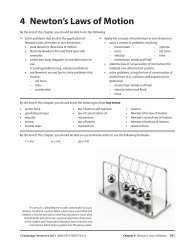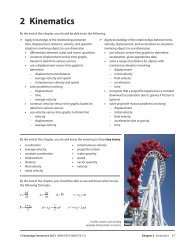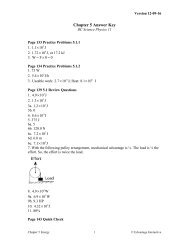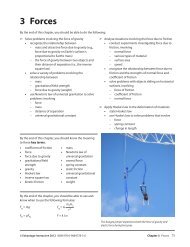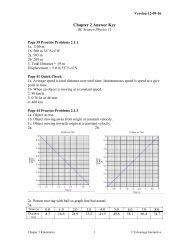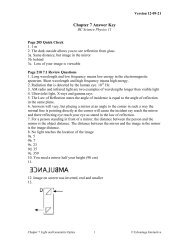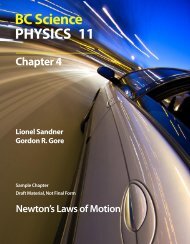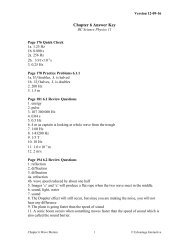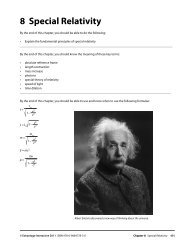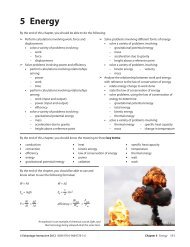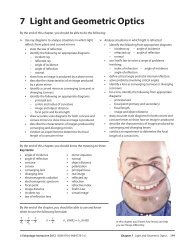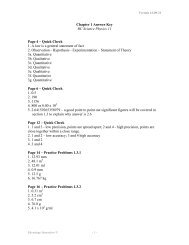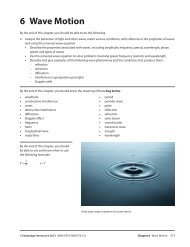1 Skills, Methods, and the Nature of Physics - BC Science Physics 11
1 Skills, Methods, and the Nature of Physics - BC Science Physics 11
1 Skills, Methods, and the Nature of Physics - BC Science Physics 11
You also want an ePaper? Increase the reach of your titles
YUMPU automatically turns print PDFs into web optimized ePapers that Google loves.
Sample Problem 1.4.3 — Use <strong>of</strong> Density as a Conversion Factor<br />
What is <strong>the</strong> volume in L <strong>of</strong> a 15.0 kg piece <strong>of</strong> zinc metal? (Density <strong>of</strong> Zn = 7.13 g/mL)<br />
What to Think About<br />
1. Decide what form <strong>of</strong> <strong>the</strong> conversion factor to<br />
use: g/mL or <strong>the</strong> reciprocal, mL/g.<br />
Always begin by arranging <strong>the</strong> factors using<br />
units only. As <strong>the</strong> answer will contain one<br />
unit, begin with one unit, in this case, kg.<br />
2. Insert <strong>the</strong> appropriate numerical values for<br />
each conversion factor.<br />
In order to cancel a mass <strong>and</strong> convert to a<br />
volume, use <strong>the</strong> reciprocal <strong>of</strong> <strong>the</strong> density:<br />
1 mL<br />
7.13 g<br />
3. Calculate <strong>the</strong> answer with correct unit <strong>and</strong><br />
number <strong>of</strong> significant digits.<br />
How to Do It<br />
15.0 kg ×<br />
15.0 kg × 103 g<br />
1 kg<br />
g<br />
×<br />
mL<br />
kg g ×<br />
× 1 mL<br />
7.13 g × 10–3 L<br />
1 mL<br />
Practice Problems 1.4.3 — Use <strong>of</strong> Rate <strong>and</strong> Density as Conversion Factors<br />
1. The density <strong>of</strong> mercury metal is 13.6 g/mL. What is <strong>the</strong> mass <strong>of</strong> 2.5 L?<br />
L<br />
= ______ L<br />
mL<br />
= 2.10 L<br />
2. The density <strong>of</strong> lead is <strong>11</strong>.2 g/cm 3 . The volumes 1 cm 3 <strong>and</strong> 1 mL are exactly equivalent. What is <strong>the</strong> volume in<br />
litres <strong>of</strong> a 16.5 kg piece <strong>of</strong> lead?<br />
3. The speed <strong>of</strong> light is 3.0 × 10 10 cm/s. Sunlight takes 8.29 min to travel from <strong>the</strong> photosphere (light-producing<br />
region) <strong>of</strong> <strong>the</strong> Sun to Earth. How many kilometres is Earth from <strong>the</strong> Sun?<br />
1 m 3 ×<br />
Conversions Involving Units with Exponents (Ano<strong>the</strong>r Kind <strong>of</strong> Derived Unit)<br />
If a unit is squared or cubed, it may be cancelled in one <strong>of</strong> two ways. It may be written<br />
more than once to convey that it is being multiplied by itself or it may be placed in<br />
brackets with <strong>the</strong> exponent applied to <strong>the</strong> number inside <strong>the</strong> brackets as well as to <strong>the</strong><br />
unit. Hence, <strong>the</strong> use <strong>of</strong> <strong>the</strong> equivalency 1 L = 1 dm 3 to convert 1 m 3 to L might appear in<br />
ei<strong>the</strong>r <strong>of</strong> <strong>the</strong>se formats:<br />
1 dm<br />
10 –1 m<br />
× 1 dm<br />
10 –1 m<br />
× 1 dm<br />
10 –1 m ×<br />
1 L<br />
1 dm3 = 1 m3 × (<br />
1 dm<br />
10 –1 m ) 3<br />
×<br />
1 L<br />
1 dm 3<br />
= 1000 L<br />
© Edvantage Interactive 2012 ISBN 978-0-9864778-3-6 Chapter 1 <strong>Skills</strong>, <strong>Methods</strong>, <strong>and</strong> <strong>the</strong> <strong>Nature</strong> <strong>of</strong> <strong>Physics</strong> 25



